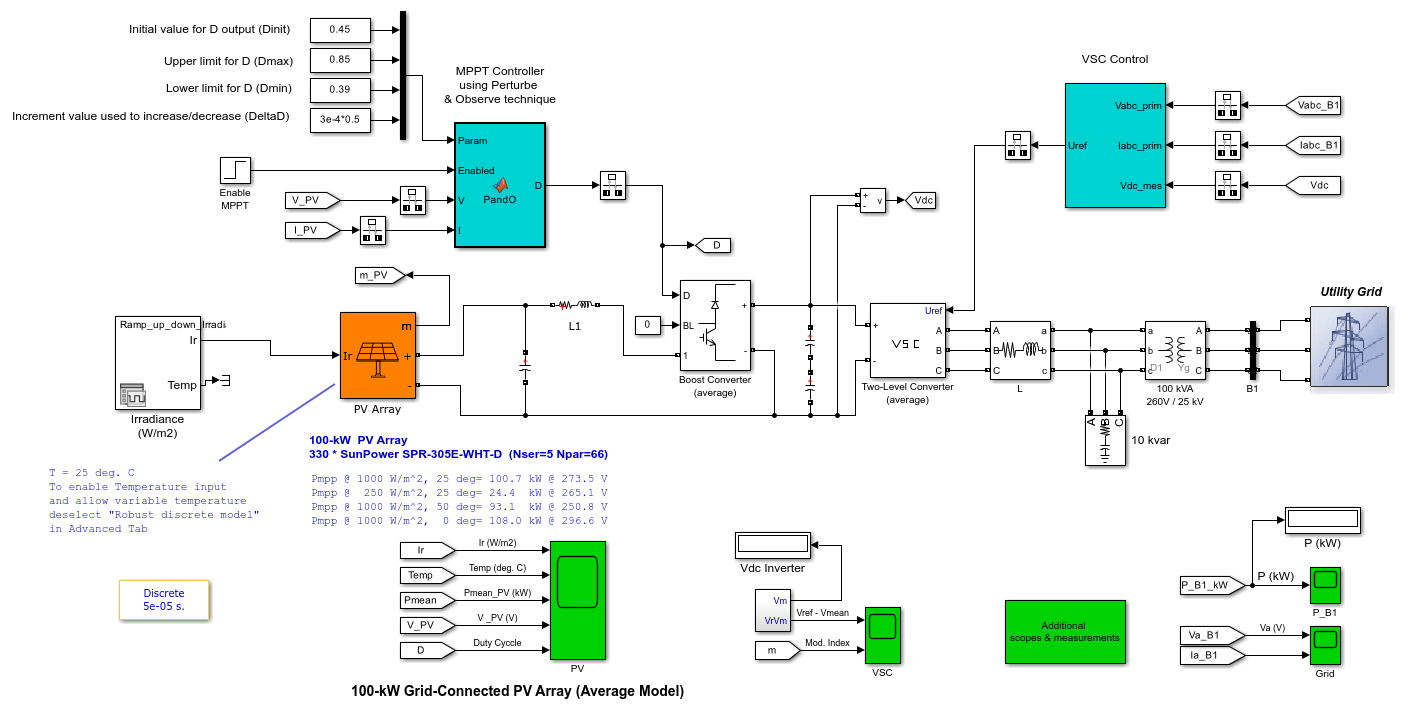Average Model of a 100-kW Grid-Connected PV Array
This example shows an average model of a 100-kW array connected to a 25-kV grid via a DC-DC boost converter and a three-phase three-level VSC.
Pierre Giroux, Gilbert Sybille (Hydro-Quebec, IREQ) Carlos Osorio, Shripad Chandrachood (The bat365)

Description
A 100-kW PV array is connected to a 25-kV grid via a DC-DC boost converter and a three-phase three-level Voltage Source Converter (VSC). Maximum Power Point Tracking (MPPT) is implemented in the boost converter by means of a Simulink® model using the 'Perturb & Observe' technique.
Another example (see PVArrayGrid model) uses detailed models for the DC_DC and VSC converters. In this detailed model the MPPT controller is based on the 'Incremental Conductance + Integral Regulator' technique.
The average model contains the following components.
PV array delivering a maximum of 100 kW at 1000 W/m^2 sun irradiance.
DC-DC boost converter (orange blocks)
3-level 3-phase VSC (blue blocks).
100-kVA 260V/25kV three-phase coupling transformer.
Utility grid
Please refer to the PVArrayGrid model for a complete description of the PV array, converters and connection to the grid.
The main difference between the detailed model and this average model is in the way that DC-DC boost converter and three-phase VSC are modeled. In this average model the boost and VSC converters are represented by equivalent voltage sources generating the AC voltage averaged over one cycle of the switching frequency. Such a model does not represent harmonics, but the dynamics resulting from control system and power system interaction is preserved. This model allows using much larger time steps than the detailed model (50 microseconds vs 1 microsecond), resulting in a much faster simulation. Note that in the average model the PV-array model contains an algebraic loop. This algebraic loop is required to get an iterative and accurate solution of the PV model when large sample times are used. This algebraic loop is easily solved by Simulink.
The 'Perturb and Observe' MPPT algorithm is implemented in the MPPT Control MATLAB® Function block.
The 100-kW PV array consists of 66 strings of 5 series-connected 305.2-W modules connected in parallel (66*5*305.2 W= 100.7 kW). Manufacturer specifications for one module are:
Number of series-connected cells : 96
Open-circuit voltage: Voc= 64.2 V
Short-circuit current: Isc = 5.96 A
Voltage and current at maximum power : Vmp =54.7 V, Imp= 5.58 A
The PV array block has two inputs that allow you varying sun irradiance (input 1 in W/m^2) and temperature (input 2 in degrees Celsius). The irradiance and temperature profiles are defined by a Signal Builder block which is connected to the PV array inputs.
Simulation
Run the model and observe the following sequence of events on Scopes.
Simulation starts with standard test conditions (25 degrees Celsius, 1000 W/m^2).
From t=0 sec to t= 0.3 sec, duty cycle of boost converter is fixed (D= 0.5 as shown on PV scope). Resulting PV voltage is therefore V= (1-D)*Vdc= (1-0.5)*500=250 V (see V_PV trace on PV scope). The PV array output power is 96 kW (see Pmean trace) whereas specified maximum power with a 1000 W/m^2 irradiance is 100.7 kW. Observe on Grid scope that phase A voltage and current at 25 kV bus are in phase (unity power factor).
At t=0.3 sec MPPT is enabled. The MPPT regulator starts regulating PV voltage by varying duty cycle in order to extract maximum power. Maximum power (100.7 kW) is obtained when duty cycle is D=0.453.
From t=0.3 sec to t=0.5 sec, the PV array operates at standard test conditions (25 degrees C, 1000 W/m^2). Duty cycle D varies between 0.450 and 0.459. PV voltage = 273.5 V (Nser*Vmp=5*54.7= 273.5 V) and mean power = 100.7 kW as expected from PV module specifications.
From t=0.5 sec to t=1.0 sec, sun irradiance is ramped down from 1000 W/m^2 to 250 W/m^2. It can be seen that this type of MPPT controller tracks maximum power only while irradiance stays constant.
From t=1.0 sec to t=1.5 sec when irradiance stays constant and equal to 250 W/m^2, duty cycle D varies between 0.466 and 0.474. Corresponding PV voltage and power are V_PV= 265 V and Pmean=24.4 kW.
From t=1.5 sec to t=6.0 sec sun irradiance is restored back to 1000 W/m^2 and then temperature is varied between 50 and 0 degrees C. in order to observe impact of temperature. Note that maximum PV output power (107.5 kW) is obtained at minimum temperature (0 degrees C).
References
For details on various MPPT techniques, refer to the following paper:
Moacyr A. G. de Brito, Leonardo P. Sampaio, Luigi G. Jr., Guilherme A. e Melo, Carlos A. Canesin "Comparative Analysis of MPPT Techniques for PV Applications", 2011 International Conference on Clean Electrical Power (ICCEP).
The module characteristics were extracted from NREL System Advisor Model (https://sam.nrel.gov/).
